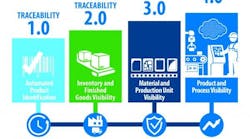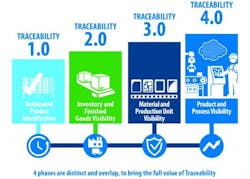Traceability...from inception to the age of Industry 4.0
By Andy Zosel, president and CEO, and Kenta Yamakawa, senior vice president, at OMRON Microscan
Traceability began with simple product and component tracking and has since expanded to include strategies that optimize productivity and quality within manufacturing operations. Technological progress has turned traceability into a ubiquitous and critical application for today’s world-class manufacturers.
Like Industry 4.0 and similar concepts, the word “traceability” can mean different things to different people or organizations. To describe traceability’s current and future phases in a global context, Omron has coined the term “Traceability 4.0,” a concept we’ll explore in this blog post.
Why is traceability important?
In manufacturing-related industries, traceability helps ensure product quality by tracking raw materials and works-in-progress throughout the production line and supply chain. In the event of a defect or contamination, a comprehensive record of everything going into the product can point to the problem’s source and minimize the impact of a recall.
As traceability-related technologies become more advanced, manufacturers are transitioning from simple track and trace to all-encompassing quality control. Barcode reading and vision inspection can be combined to separate good products from bad products in real time, and the data contained in barcodes can automatically direct the system to take the next steps.
Traceability 1.0: Product visibility
Basic traceability was transformational when it started being used to process a large number of discrete items or transactions. Starting with the use of barcodes, the ability to mark a part and then track it was groundbreaking. Traceability 1.0 consists of automatically identifying products to drive accuracy and efficiency.
Barcodes continue to be core elements in manufacturing and other industries, and they often serve as the first step in implementing traceability solutions. In clinical diagnostics, for example, 1D barcodes are used to track individual specimens throughout laboratory testing equipment.
Traceability 2.0: Supply chain visibility
Now that barcodes were being applied to manufactured items, manufacturers saw that they could also be used to track materials within the manufacturing facility and throughout the supply chain. Traceability 2.0 helps manage inventory and enables targeted product recalls, reducing the cost of quality improvement and increasing consumer confidence.
Recalls can be extremely expensive for any manufacturer that runs into a major quality issue. Because Traceability 2.0 helps pinpoint exactly which items must be recalled based on date and lot codes, its demand has skyrocketed.
Traceability 3.0: Line item visibility
Traceability 3.0 is about the optimization of manufacturing and supply chain security by focusing on everything that’s necessary to build a product – raw material, components, subcomponents, and the finished product with serial number.
Manufacturers extended traceability to their suppliers by requiring barcodes and other identifying information on components and packaging. As more suppliers added information, manufacturers optimized processes and product quality even further by employing traceability within their facilities.
Traceability 4.0: Process visibility
The union of product, component and supply chain tracking is what Omron has dubbed “Traceability 4.0.” This stage includes all machine and process parameters required to achieve the highest level of manufacturing, such as overall equipment effectiveness (OEE) as well as production and quality data to improve overall manufacturing effectiveness.
Although some manufacturers are already employing Traceability 4.0, it represents the future for the majority of companies. Facilitated by smart sensors, AI controllers, RFID and advanced data management software, Traceability 4.0 systems can make automatic decisions that optimize equipment and processes based on acquired data, including predictive maintenance.
For manufacturers interested in getting started with this advanced stage of traceability, it can be helpful to understand the history of this essential manufacturing strategy. Visualizing the expanding capabilities of traceability in tandem with technological advancements can shine light on its immense potential for production and quality enhancements.



